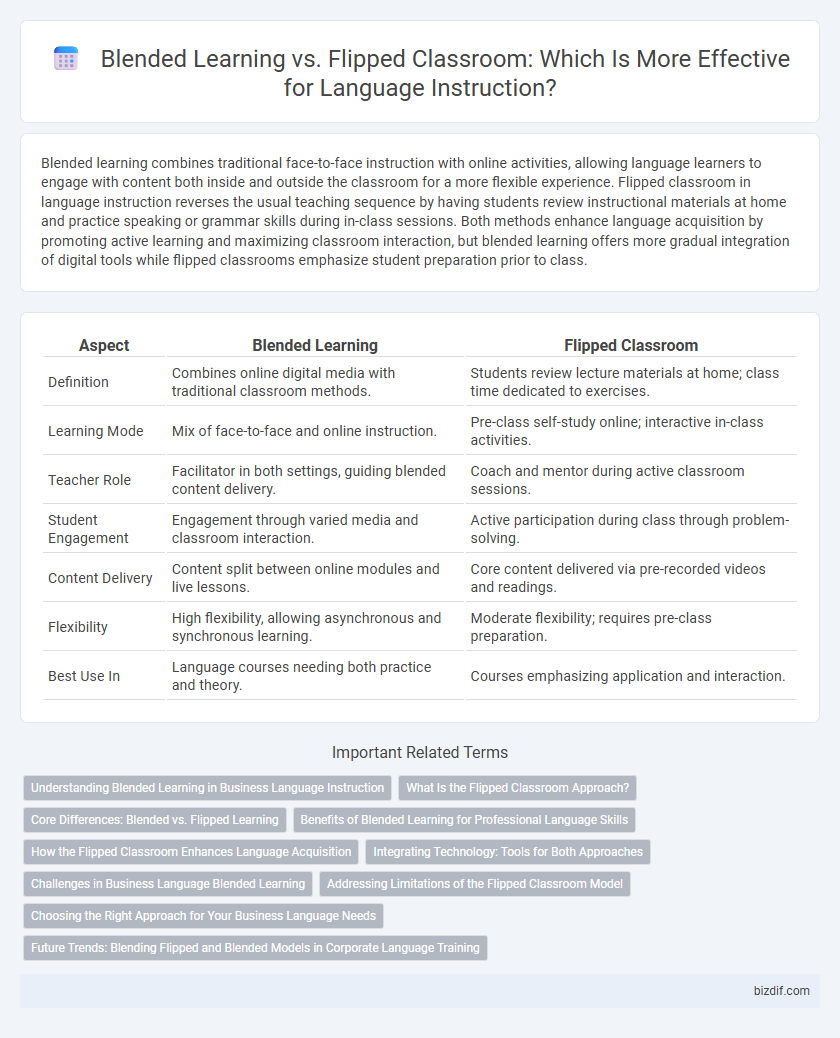Blended learning combines traditional face-to-face instruction with online activities, allowing language learners to engage with content both inside and outside the classroom for a more flexible experience. Flipped classroom in language instruction reverses the usual teaching sequence by having students review instructional materials at home and practice speaking or grammar skills during in-class sessions. Both methods enhance language acquisition by promoting active learning and maximizing classroom interaction, but blended learning offers more gradual integration of digital tools while flipped classrooms emphasize student preparation prior to class.
Table of Comparison
| Aspect | Blended Learning | Flipped Classroom |
|---|---|---|
| Definition | Combines online digital media with traditional classroom methods. | Students review lecture materials at home; class time dedicated to exercises. |
| Learning Mode | Mix of face-to-face and online instruction. | Pre-class self-study online; interactive in-class activities. |
| Teacher Role | Facilitator in both settings, guiding blended content delivery. | Coach and mentor during active classroom sessions. |
| Student Engagement | Engagement through varied media and classroom interaction. | Active participation during class through problem-solving. |
| Content Delivery | Content split between online modules and live lessons. | Core content delivered via pre-recorded videos and readings. |
| Flexibility | High flexibility, allowing asynchronous and synchronous learning. | Moderate flexibility; requires pre-class preparation. |
| Best Use In | Language courses needing both practice and theory. | Courses emphasizing application and interaction. |
Understanding Blended Learning in Business Language Instruction
Blended learning in business language instruction combines traditional face-to-face teaching with digital resources, enabling flexible access to language practice and real-time feedback. This approach enhances learner engagement by integrating online modules, interactive exercises, and in-person communication skills training tailored to professional contexts. Data shows that employees participating in blended learning programs demonstrate improved language retention and application in workplace scenarios compared to conventional methods.
What Is the Flipped Classroom Approach?
The flipped classroom approach reverses traditional teaching by delivering instructional content, often online, outside of class, while in-class time is dedicated to interactive activities and personalized support. This model enhances student engagement and allows for deeper understanding through collaborative exercises and immediate feedback. In language instruction, it enables learners to practice speaking, listening, and comprehension skills more effectively during class sessions.
Core Differences: Blended vs. Flipped Learning
Blended learning integrates online digital media with traditional classroom methods, allowing students to access materials both in-person and remotely, enhancing flexibility and personalized pace. Flipped classroom reverses the typical learning environment by delivering instructional content, often online, outside of class, and uses classroom time for interactive activities and deeper discussion. Core differences lie in the structure: blended learning balances online and face-to-face instruction constantly, while flipped classroom shifts lecture delivery outside class to maximize engagement during in-person sessions.
Benefits of Blended Learning for Professional Language Skills
Blended learning enhances professional language skills by combining online digital tools with traditional classroom instruction, allowing for flexible, personalized learning experiences. It promotes continuous practice and immediate feedback, which accelerates language acquisition and improves communication proficiency in professional contexts. This approach also supports diverse learning styles and provides access to authentic materials, fostering real-world language application and cultural competence.
How the Flipped Classroom Enhances Language Acquisition
The Flipped Classroom enhances language acquisition by shifting traditional instruction to pre-class activities, enabling more interactive and communicative practice during class time. Learners engage with targeted multimedia content, such as videos and podcasts, at their own pace, which promotes better vocabulary retention and listening comprehension. This approach increases active student participation and immediate feedback, resulting in improved speaking skills and overall language proficiency.
Integrating Technology: Tools for Both Approaches
Blended learning and flipped classroom models both leverage technology to enhance language instruction by integrating digital tools such as learning management systems, interactive apps, and multimedia resources. Blended learning combines in-person and online activities, utilizing platforms like Moodle or Canvas to provide flexible access to language exercises and assessments. The flipped classroom emphasizes pre-class video lectures and interactive online quizzes, enabling students to prepare independently and engage in collaborative, technology-supported practice during face-to-face sessions.
Challenges in Business Language Blended Learning
Challenges in business language blended learning include maintaining consistent engagement across in-person and online platforms, which can lead to uneven skill development. Learners often struggle with self-discipline during online components, impacting the overall effectiveness of the program. Technical issues and the need for effective integration of business-specific content further complicate the delivery of seamless blended learning experiences.
Addressing Limitations of the Flipped Classroom Model
Blended learning addresses limitations of the flipped classroom model by integrating in-person and online instruction to provide flexible, personalized language practice, which helps overcome students' lack of motivation and uneven preparation. The model allows instructors to monitor progress in real-time and offer immediate feedback, enhancing comprehension and engagement. Combining synchronous and asynchronous methods reduces dependency on pre-class preparation, ensuring all learners receive adequate support during active learning sessions.
Choosing the Right Approach for Your Business Language Needs
Blended learning integrates traditional face-to-face instruction with online components, offering flexibility and personalized language training tailored to business schedules. The flipped classroom model emphasizes pre-class content delivery through digital materials, maximizing in-person time for interactive, application-based language practice aligned with specific corporate goals. Selecting the right approach depends on factors such as employee availability, learning objectives, and the desired balance between self-paced study and guided instruction to enhance business communication skills effectively.
Future Trends: Blending Flipped and Blended Models in Corporate Language Training
Future trends in corporate language training emphasize the integration of blended learning and flipped classroom models to enhance learner engagement and efficiency. Combining asynchronous digital resources with interactive, in-person or virtual sessions allows for personalized language acquisition pathways tailored to diverse learner needs. This hybrid approach leverages real-time practice and instant feedback while maximizing flexible access to instructional materials.
Blended Learning vs Flipped Classroom Infographic

 bizdif.com
bizdif.com